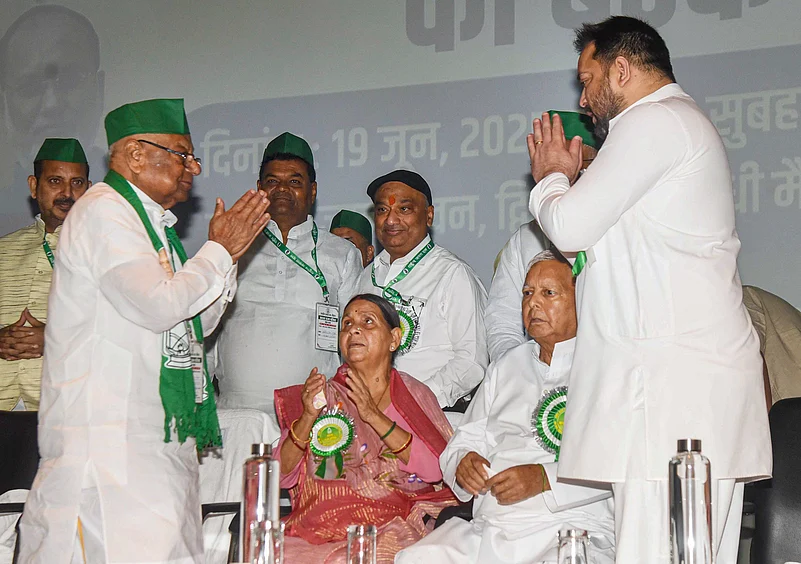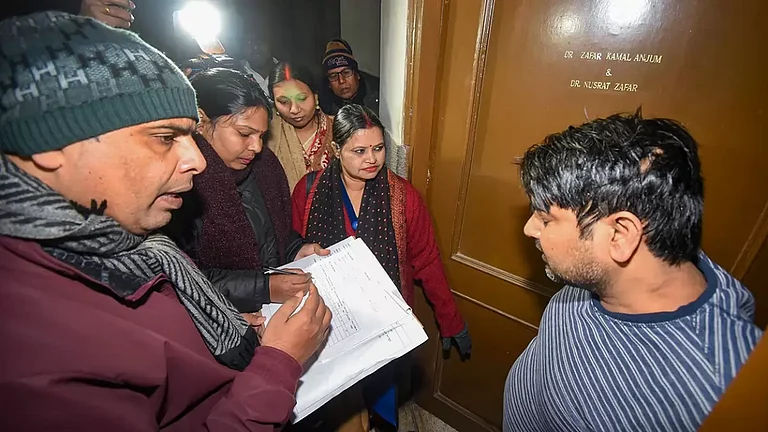After the caste-based survey, the political focus in Bihar has intensified around the Extremely Backward Classes (EBC). Recently, during a rally in Siwan, Prime Minister Narendra Modi mentioned the ‘Extremely Backward’ community four to five times in his speech, emphasising their development and welfare while announcing various projects.
Congress leader Rahul Gandhi has consistently advocated for political representation and reservations for communities based on their population share. Meanwhile, leaders like Lalu Prasad Yadav and Nitish Kumar have historically relied on the votes of the EBCs to ascend to power.
Currently, the Rashtriya Janata Dal (RJD) is striving to win over this vote bank, and in line with that effort, Mangani Lal Mandal, who belongs to the EBC community, has been appointed as the party’s state president. His appointment, just ahead of the elections, is being seen as symbolic. When asked about this, RJD’s national spokesperson Jayant Jigyasu said: “No mainstream party in Bihar had ever appointed someone from the EBC community as its state president. Now that the RJD has done so, it’s being criticised. The RJD has always considered the interests of all communities. It has sent the most number of EBCs to the Rajya Sabha, appointed EBC ministers in the 2004 central government, regularly nominated them to the Legislative Council, and is the first party in India to provide reservation to EBCs in internal organisational elections.”
While the RJDs first three state presidents were from the Dalit community, the rest were from the minority, backward, and upper-caste communities. On June 15, for the first time, someone from the EBC community was appointed to the role.
Why are the EBCs so important in Bihar’s elections? The answer lies in the data from the 2023 caste-based survey in Bihar. According to the survey, the total population of backward castes is 63 per cent, out of which 36 per cent belongs to the EBC category. Additionally, Dalits make up 19.65 per cent, Muslims 18 per cent, and upper castes 15.5 per cent. Out of Bihar’s total population of 13.7 crore, EBCs alone constitute around 4.7 crore. This is why every political party is eager to court this demographic.
However, the BJP maintains that no matter what the RJD does, it remains confined to the Muslim-Yadav (MY) vote base. Bihar BJP spokesperson Neeraj Kumar stated: “The RJD is out of the game. Tejashwi Yadav’s tone reflects desperation. They will not get the support of the EBC and OBC voters. They’re limited to MY—and even among Yadavs, the educated segment is moving away from them. If Tejashwi cannot manage his own house, how can he manage the EBC community?”
According to Kumar, the EBC community has previously stood with the NDA under Nitish Kumar’s leadership and will continue to do so in the future.
For the past 40 years, Bihar politics has revolved around two prominent backward caste leaders—Lalu Prasad Yadav and Nitish Kumar. The communities that played a crucial role in bringing them to power were primarily from the EBC segment.
During RJD’s 15-year rule (1990–2005), Lalu took several major decisions in favour of the EBCs, most notably expanding their reservation quotas. This ensured that a large segment of the EBC community remained aligned with him for over a decade. However, some of his later decisions and the growing Yadav dominance within the party made EBCs uncomfortable, leading them to shift their support to Nitish—eventually resulting in RJD’s loss of power.
Since then, the RJD has been trying to win back the EBCs. Under Tejashwi Yadav’s leadership, these efforts have intensified. In 2023, the party introduced reservation for EBCs and Dalits in its organisational structure at the district and block levels—another step in Tejashwi’s ongoing campaign to regain the trust of this vital voter base.
Senior journalist Pushyamitra says: “Apart from the 18 per cent Muslim and 14 per cent Yadav vote, the RJD doesn’t receive much support. The party wants to expand its voter base. In this effort, they initially tried to attract the Bhumihar community, then the Kushwahas. When these attempts failed, they shifted focus to the EBCs. That’s why they kept Mukesh Sahani (the founder of the Vikassheel Insaan Party) close during the alliance phase. But he doesn’t hold significant influence over his own caste group, and questions have been raised about his credibility. Appointing Mandal as the state president is just another attempt by RJD to appeal to this section.”
Sahani also belongs to the EBC community. Tejashwi has been consistently involving Sahani in every event, aiming to win over the 9 per cent Nishad population in Bihar through him. If successful, this could increase the vote share of the INDIA bloc in the state.
Mandal, a former Bihar minister and MP, has extensive experience working alongside Bharat Ratna recipient and people’s leader Karpoori Thakur since his student politics days. Pushyamitra believes that this past association is Mandal’s only significant political asset, and at this stage of life, he no longer has a strong influence within his community.
The Rashtriya Ati Pichhra Morcha (National EBC Front) views the appointment of Mandal as part of RJD’s electoral strategy. Its national president, Vijay Kumar Chaudhary, says that ever since the caste-based population data was released, political parties have been vying to win over the EBC community. He adds: “Appointing someone as state president or giving representation within the party won’t change the condition of the entire community. The real question is: who is actually talking about our issues and demands? Our demand is that based on our population share, we should be allotted 90–92 assembly seats in Bihar.”
Currently, only around 30 out of Bihar’s 243 MLAs are from the EBC community, though their population suggests they should have representation on 87–88 seats. According to the EBC Front, there were 19 EBC MLAs in 2015, 17 in 2010, 19 in 2005, 14 in 2000 and 1995, and only eight in 1990.
The Front argues that their population is 38 per cent, which should translate to 92 MLAs in the Legislative Assembly, 15 in the Legislative Council, 14 seats in the Lok Sabha, and six in the Rajya Sabha. However, currently, only six EBC members are in the Bihar Legislative Council, three in the Rajya Sabha, and six in the Lok Sabha.
Over time, various governments—under both Lalu and Nitish—have made decisions benefiting these communities, including reservations in government jobs and Panchayat elections. However, the historic foundation for their inclusion was laid by Karpoori Thakur. When he became Chief Minister in 1971, he formed the Backward Classes Commission. Later, CM Bhola Paswan Shastri established the Mungeri Lal Commission. This commission classified 93 castes as EBC and 35 as OBC. On November 10, 1978, Karpoori Thakur implemented this report and announced 26 per cent reservation for backward classes—10 per cent for OBCs, 12 per cent for EBCs, and four per cent for other communities.
During RJD’s tenure in 1997-2002, the reservation quota was increased to 18 per cent for EBCs and 12 per cent for OBCs. Later, under Nitish Kumar’s government, 20 per cent reservation was introduced for EBCs in panchayat elections, along with several other schemes targeting their welfare.
But the core question remains: Despite playing a crucial role in bringing both Lalu and Nitish to power, why has no strong face from the EBC community emerged as Chief Minister or Deputy Chief Minister in four decades? Why hasn’t their representation in the legislature matched their population share?
There are 112 castes within the EBC category, but only 11 of them have a population of one per cent or more. Around 70 castes have populations of less than 1 lakh, 65 castes have fewer than 30,000 people, and 35 have less than 10,000. This extreme fragmentation is believed to be the reason why the community lacks cohesion—unlike other caste groups. The lack of unity among EBCs is one major reason why no towering leader has emerged from within. According to Vijay Kumar Chaudhary of the National EBC Front, political parties deliberately keep this fragmented community divided for their own political gains.
It is being said that Tejashwi Yadav is now attempting to follow the path of Nitish Kumar’s “social engineering” model, trying to bring together all castes under one umbrella. In particular, he is trying to move the RJD away from its long-held “MY” identity.
In the run-up to this year’s Bihar Assembly elections, all major political parties are making promises and claims regarding the EBCs. One of the prominent proposals is to allocate seats based on caste representation.


















